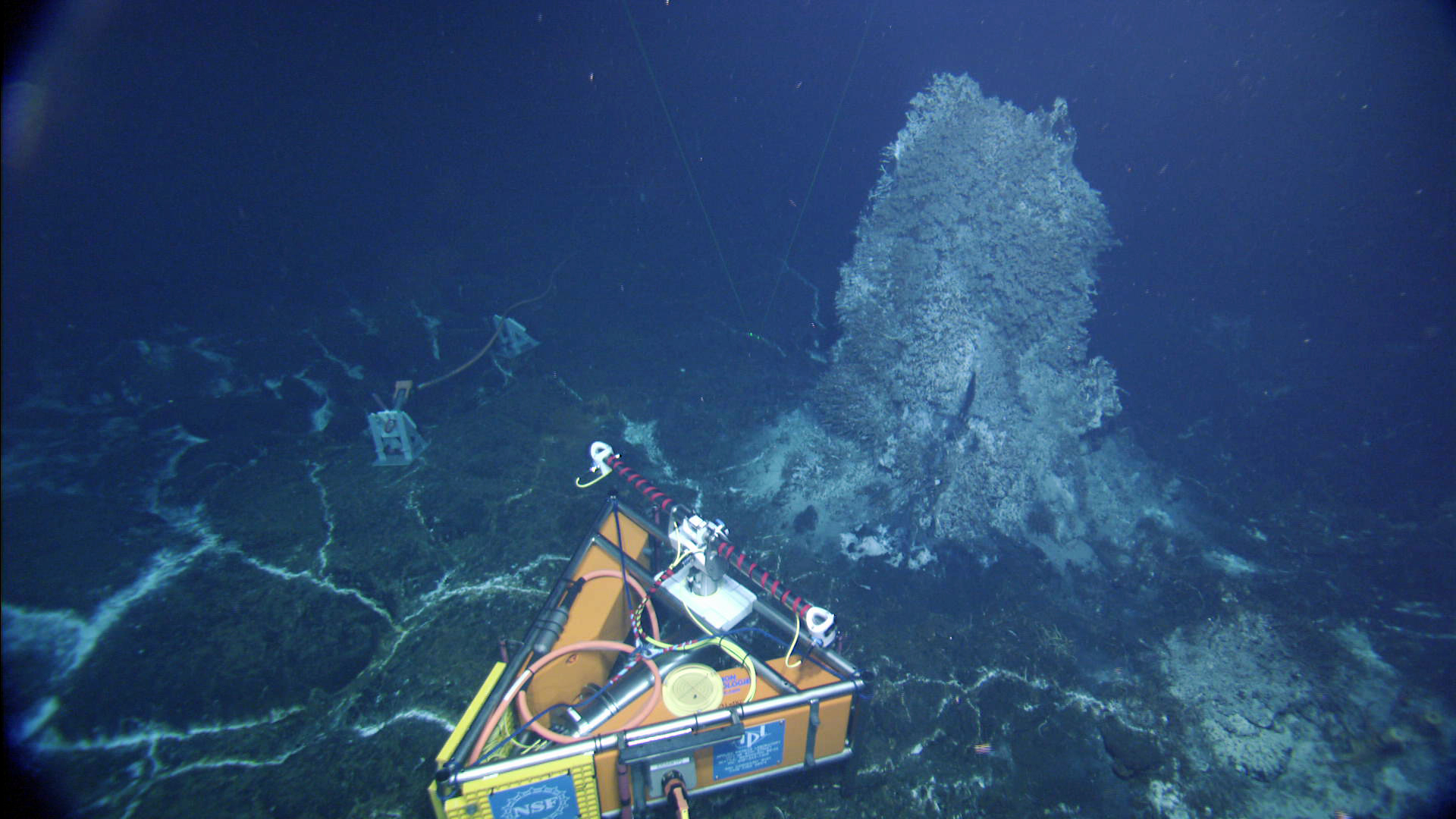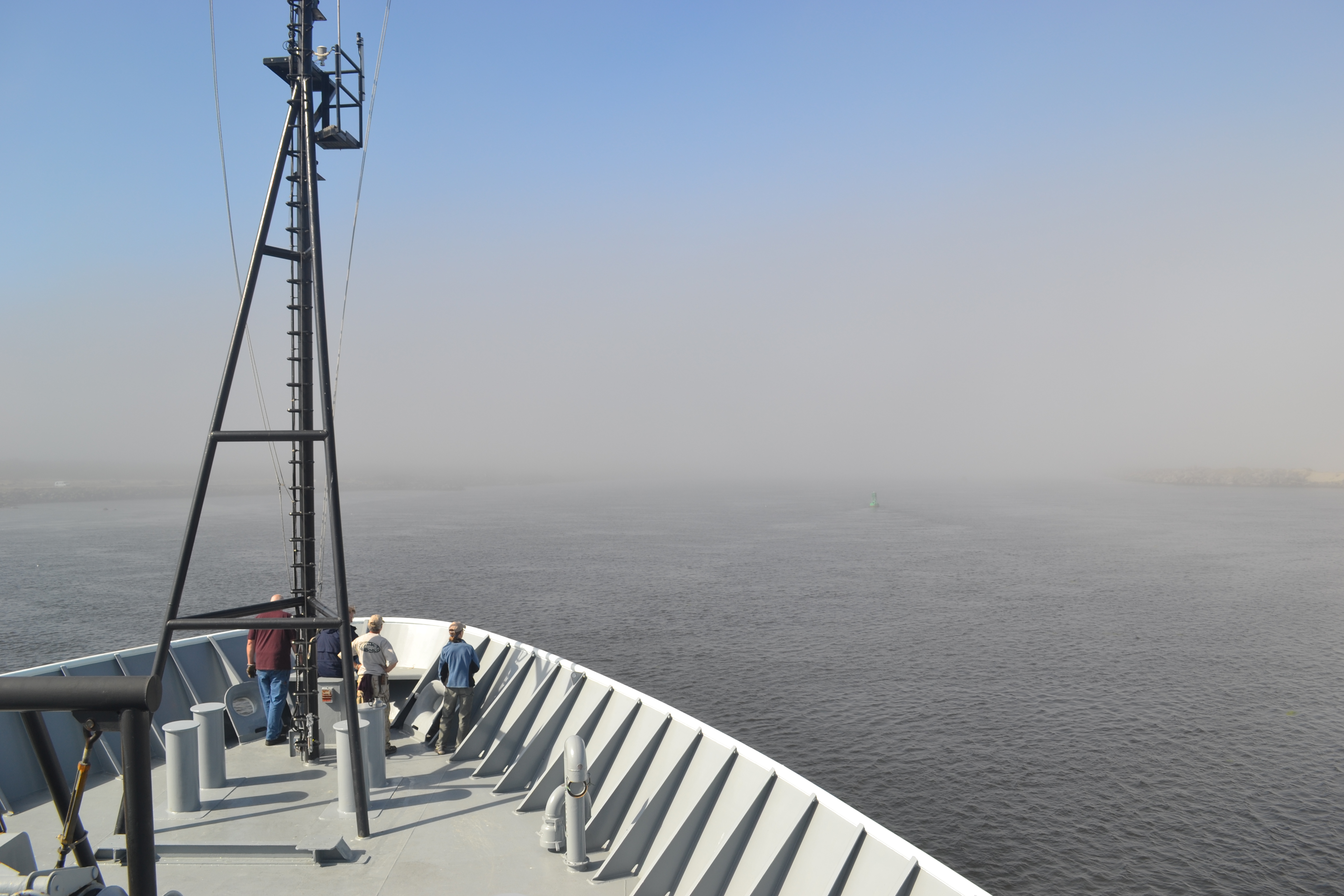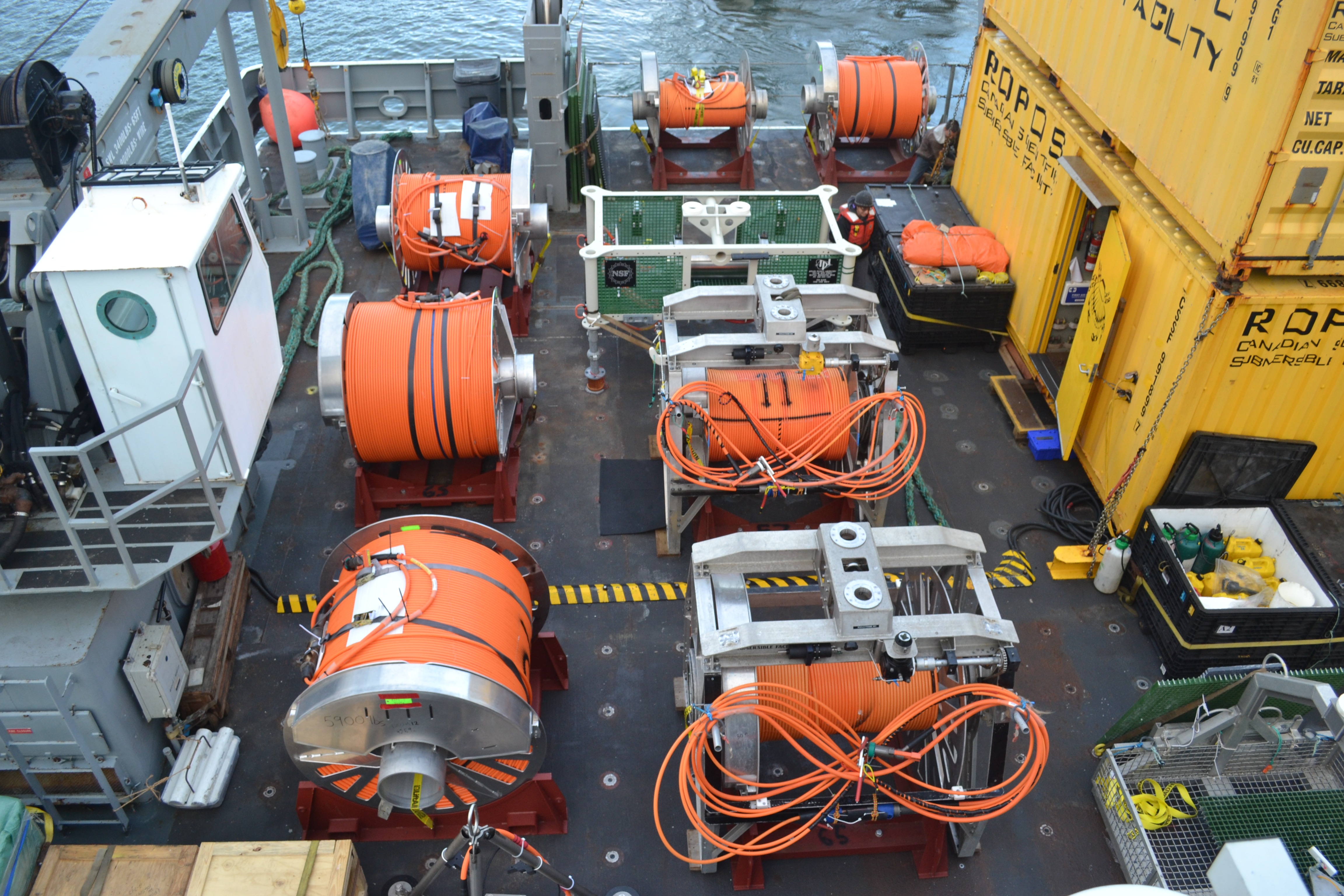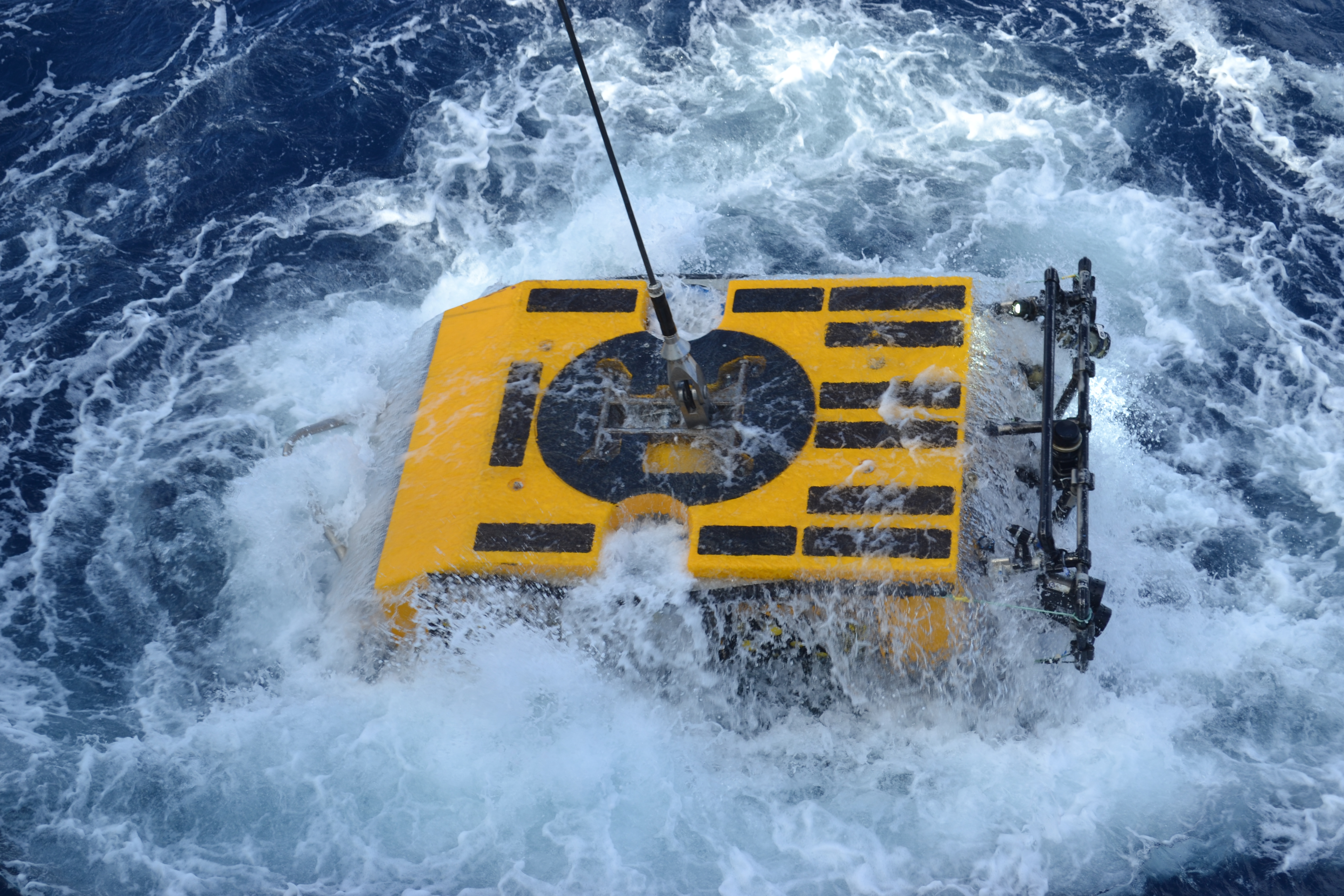Image Archive





























This remote fluid access (RAS) and DNA sampler was deployed at the massive black smoker edifice called Hulk in the Main Endeavour Hydrothermal Field. The green lasers are 10 cm apart.

The RCA high definition camera at the base of the hydrothermal vent called Mushroom. Credit: UW/NSF-OOI/CSSF; ROPOS Dive R1636; V13.

During ROPOS Dive 1611, the ROV latched into the remotely operated cable laying system (ROCLS) hosting a drum with an RSN extension cable ready to be installed. In concert, these two systems successfully installed >22,000 m of extension cables on the seafloor during the UW-OOI-NSF VISIONS'13 expedition.

With ROPOS's heavy lift capabilities and industry style latch system on its underbelly, it is able to safely take heavy loads to the seafloor. During the VISIONS'13 Expedition, ROPOS takes two short-period seismometers to the seafloor in the tool basket at the start of Dive 1617 to the caldera of Axial Seamount.

During the UW-OOI-NSF VISIONS'13 Expedition, the remotely operated vehicle ROPOS installed three medium power J-Boxes (secondary nodes) utilizing their special 4,000 lb heavy lift capabilities. ROPOS took this RSN J-Box down on dive R1601. The broad feet on the J-Box are used for installation in heavily sedimented areas. This was an unusually calm day at sea in the NE Pacific. Photo Credit: Mitch Elend, University of Washington.

A cable termination assembly (CTA) is removed from the cable drum that was just released from the Remotely Operated Cable Laying System (ROCLS) during the ROV ROPOS dive 1599. The CTA, held in ROPOS's manipulator, provides a termination/connection between wetmate connectors and extension cables. An RSN wetmate hybrid connector (RS03W3-PA) is shown in the background, still attached to an extension cable that is figure 8'ed on the front horns of the cable drum. Photo credit: NSF-OOI/UW/CSSF.

An ODI hybrid wet-mate connector provides > 1 Gbs video transmission capabilities and power to the RSN-OOI-NSF high definition camera that was deployed during the VISIONS'13 Expedition. The wetmate connectors allow an ROV to connect and disconnect infrastructure underwater without having to recover the equipment. The camera shown here is at a water depth of ~ 5000 ft at the summit of Axial Seamount. The orange extension cable (on right of camera) was powered up by the ROV ROPOS through an ~ 4 km extension cable that traverses eastward across the caldera at Axial Seamount. Live video video from the HD camera was streamed over the Internet for several hours during testing of the camera. In 2014, the extension cable will be connected to Primary Node 3B for 365 day access. The camera was installed at the base of the hydrothermal chimney called Mushroom in the ASHES hydrothermal field. Photo credit: NSF-OOI/UW/CSSF.

This medium powered junction-box (MJ03B) in the ASHES hydrothermal field was installed during the VISIONS'13 expedition. The titanium cylinder inside the frame hosts the power converters, data ports, and communication capabilities to shore via the Primary Nodes. A 4.3 km cable extends from this J-Box across the caldera to PN3B, where it awaits future connection. MJ03B was installed as a 'subnet' during VISIONS'13 - two short-period seismometers are now connected to it via a 50 m and 1.2 km extension cable, respectively. A also host a cabled 3D thermistor array (a test instrument is shown in this image - triangular shaped frame with blue cables) was also deployed for testing. MJ03B, and all cables and connected sensors were fully tested during VISIONS'13, and are fully functional. During the several hour test period, several earthquakes were detected.

A dolphin streams ahead of the R/V Thompson as the ship transits home from 47 days at sea. Credit: Cody Turner, University of Washington, V13.

The ~ 4 m tall chimney called Inferno in the ASHES hydrothermal field sprouts a very young (< 2 year old) fragile beehive. The beehive structure is composed of very fine-grained sulfide minerals and anhydrite. Lush assemblages of tube worms, palm worms and limpets grow on the outer walls of the edifice. VISIONS '13, LEG 4. Photo credit: NSF-OOI/UW/CSSF

A short-period seismometer (OBSSPA301) is installed ~1.3 km east of the ASHES hydrothermal field. A cable connects to a medium power junction box in the field. During testing with ROPOS, this seismometer recorded a small earthquake. Credit: UW/NSF-OOI/CSSF, ROPOS Dive R1640; V13.

A Deep-Sea Cucumber (Holothurian) is shown with brittle stars and a seastar on a lobate flow on Axial Volcano. This is likely the species Pannychia moseleyi. Photo credit: NSF-OOI/UW/CSSF; V13

The summit of this hydrothermal chimney, called 'Eascargot', has a striking resemblance to a snail. A 270°C actively venting site (two small white chimneys mid structure) will host a cabled temperature-resistivity sensor there in 2014. This sensor will provide real-time data on the fluid chemistry (chlorinity) -temperature relationships inside the vent. The instrument was designed by Marv Lilley, University of Washington. VISIONS '13, Leg 4. Photo credit: NSF-OOI/UW/CSSF

This short-period seismometer was deployed on a flat sheet flow ~ 1.3 km east of the ASHES hydrothermal field in 2013. The black ball in the yellow circle shows that it is perfectly level, helping to insure that the highest quality data comes off of this network. Axial Volcano is likely to be quite seismically active and we are anxious to get the real-time data on shore next year. This will help us understand magma and fluid migration in the subsurface of the volcano...and eventually these data may help us predict an eruption. Several earthquakes were detected in real-time during testing of these seismometers in 2013. Credit: UW/NSF-OOI/CSSF, ROPOS Dive R1635; V13.

High-temperature, near-boiling fluids jet from small spigots on the top of the metal-sulfide, black-smoker chimney called El Guapo (the handsome one) in the International District Hydrothermal Field. VISIONS '13, Leg 4. Photo credit: NSF-OOI/UW/CSSF

Water streams off ROPOS as it is being recovered onto the deck of the R/V Thompson - it was a beautiful blue-sky day. Photo Credit: Mitch Elend, University of Washington. VISIONS '13, Leg 4

The ROV ROPOS powers up the RSN-OOI camera for the first time at the hydrothermal chimney called Mushroom. This image is from ROPOS with the vehicle lights off, and only the RSN-OOI HD camera providing illumination of the chimney while collecting the first video imagery from the seafloor, which was then streamed live over the Internet. Photo credit: NSF-OOI/UW/CSSF.

A large Fried Egg Jellyfish (Phacellophora cantschatica) hugs the basalts along the floor of Axial Seamount. The jellyfish is likely a 'fried egg' jelly. Credit: UW/NSF-OOI/CSSF; ROPOS Dive R1635, V11.

A 3D thermistor array designed by RSN Project Scientist Dr. Giora Proskurowski is deployed in the ASHES vent field for testing. A similar system will be deployed and powered up next summer, providing real-time 24/7 temperature data over the Internet for all to use/see. The blue cable holds 24 temperature sensors and was provided by RBR Ltd. The array will be placed in a diffuse flow site at the base of the vent called Mushroom, a site hosting abundant vent fauna. These data, coupled with seismic information, fluid chemistry, and HD imagery will be used to see how these systems evolve over time and how earthquakes influence chemical and biological processes. VISIONS '13, Leg 4 Photo credit: NSF-OOI/UW/CSSF

This 60-m extension cable will soon host a high-definition video camera to be deployed at the Mushroom hydrothermal vent (far left). White microbial mats along narrow fractures in the lobate lava flows mark areas where low-temperature diffuse hydrothermal fluids issue from the seafloor. The 7-function manipulator arms of the Canadian ROV ROPOS gently place the wet-mate connector holding plate on the seafloor. VISIONS '13 Leg 4 Photo credit: NSF-OOI/UW/CSSF.

The 3D thermistor array designed by RCA Project Scientist Giora Proskurowski is attached to the Medium Powered J-BOx (MJ03B) in the ASHES hydrothermal field. The array will be tested on a follow-on dive, and in 2014 it will be deployed in a diffuse flow site at the base of the vent called Mushroom, along with a high-definition video camera and an osmo vent fluid sampler. Credit: UW/NSF-OOI/CSSF; V13.

ROPOS decends to the seafloor during the VISIONS'13 expedition. Photo Credit: Mitch Elend, University of Washington

The R/V Thompson crew watches from the bow as the Thompson transits through the channel our of Newport Oregon into the Pacific for the start of Leg 4 of the VISIONS'13 Expedition. Photo Credit: Mitch Elend, University of Washington.

Beautiful striated pillow basalts form a thick flow on the floor of Axial Seamount. Credit: UW/NSF-OOI/CSSF, ROPOS Dive R1630; V13

Dr. Danny Grumbaum and Owen Coyle are developing this sea-going, flow-through system. VISIONS '13, Leg 3

Numerous spools of extension cables await deployment on Leg 3. When completed, the VISIONS13 program will have installed ~23,000 m of cable on the seafloor.

ROPOS enters the water on dive 1604 during VISIONS'13. Photo Credit. Mitch Elend.

A fossilized lava pond reflects past circulation of melt on the seafloor in a small lava lake. The surface is glass, and fine sediments highight the whirl. VISIONS '13, Leg 4 Photo credit: NSF-OOI/UW/CSSF
- Anemone
- Animal
- Arthropod
- ASHES
- Axial
- Axial Base
- Axial Biology
- Axial Caldera
- Bacteria
- Basalt Lava
- BEP
- Biofouling
- biolgoy
- Biology
- Camds
- Camera
- Camhd
- Central Caldera
- Ciliates
- Cnidaria
- Coastal Biology
- Crab
- Deep Profiler Mooring
- Dive Highlights
- Eastern Caldera
- Echinoderms
- Endurance Array
- Engineering Team
- ENLIGHTEN 10
- Exploratorium
- Fish
- Geology
- HD Camera
- HPIES
- Hydrate Ridge
- Hydrates
- Hydrophone
- Hydrothermal Vents
- Illustration
- Inshore 80 Meters
- Instrument
- International District
- J-BOX
- Jason
- Jellyfish
- Junction Box
- K12
- Lava
- Mollusk
- Moorings
- Nodes
- Nudibranch
- Octopus
- OOI
- Oregon Offshore
- Oregon Offshore 600 m
- Oregon Shelf
- Oregon Slope Base
- People
- PN1B
- PN1D
- Polychaetes
- PPSDN
- Primary Node
- RASFL
- ROCLS
- ROPOS
- ROPOS Dives
- ROV Team
- RV Revelle
- RV Sikuliaq
- RV Thompson
- Salp
- Sample
- SC13
- Science Team
- Sea Cucumber
- Sea Star
- Sea Urchin
- Seafloor
- Seismometer
- Sensors
- Shallow Profiler Mooring
- Shark
- Shipboard
- Shore Station
- Slope Base
- Smoker
- Soft Coral
- Southern Hydrate Ridge
- Sponge
- Squid
- Students
- Students & Guest Participants
- Tmpsf
- Tubeworms
- VISIONS 11 Leg 1
- VISIONS 11 Leg 2
- VISIONS 11 Viewers
- VISIONS 13
- VISIONS 14
- VISIONS 15
- VISIONS 16
- VISIONS 17
- VISIONS 18
- VISIONS 20
- VISIONS 22
- VISIONS 23
- Visualization
